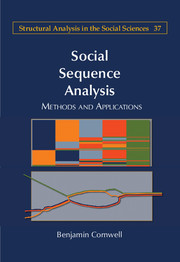Book contents
- Frontmatter
- Contents
- List of Figures
- List of Tables
- Preface
- Acknowledgments
- PART I INTRODUCTION
- PART II THEORETICAL BACKGROUND
- PART III SOCIAL SEQUENCE ANALYSIS CONCEPTS AND TECHNIQUES
- PART IV NEW DIRECTIONS IN SOCIAL SEQUENCE ANALYSIS
- PART V CONCLUSIONS
- 8 The Promise of Social Sequence Analysis
- Appendix A Recent Whole-Sequence Pattern Analyses
- Appendix B Linkage Criteria for Agglomerative Hierarchical Clustering
- References
- Index
- Recent Books in the Series (continued from page iii)
8 - The Promise of Social Sequence Analysis
from PART V - CONCLUSIONS
Published online by Cambridge University Press: 05 July 2015
- Frontmatter
- Contents
- List of Figures
- List of Tables
- Preface
- Acknowledgments
- PART I INTRODUCTION
- PART II THEORETICAL BACKGROUND
- PART III SOCIAL SEQUENCE ANALYSIS CONCEPTS AND TECHNIQUES
- PART IV NEW DIRECTIONS IN SOCIAL SEQUENCE ANALYSIS
- PART V CONCLUSIONS
- 8 The Promise of Social Sequence Analysis
- Appendix A Recent Whole-Sequence Pattern Analyses
- Appendix B Linkage Criteria for Agglomerative Hierarchical Clustering
- References
- Index
- Recent Books in the Series (continued from page iii)
Summary
Social life is inherently dynamic. Over the past couple of decades, social scientists have turned to analytic methods that afford greater insight into these dynamics. We have begun to see that it is not sufficient to examine actors or particular elements of the social world as objects of study, the connections among them, or the causes and consequences of these phenomena. Dynamic paradigms shift the focus to transitions, processes, holistic trajectories, and other ordered social phenomena. Social scientists now have both the data and the technology that are needed to make sense of these phenomena. The new techniques and directions for research that are described herein promise to provide valuable insights into the dynamics of social life that have for too long been neglected in the social sciences.
With the primary goal in mind of broadening the reach of social sequence analysis, this book has attempted to make several contributions to this body of methods. First, this book packages together this set of otherwise rarely combined, interdisciplinary analytic methods. Where possible, I have attempted to identify the common threads, similarities, and complementary features that link these methods together. From where I sit, there are enough similarities to recognize that these methods constitute a social sequence analysis paradigm. This book has also sought to merge the insights of social network analysis and social sequence analysis. This hybrid analytic framework gives rise to new approaches to exploring connections among social actors and elements of the social world, facilitates viewing sequences as nonlinear constructs, and paves the way for more wholesale integration of statistical inference into social sequence analysis without the loss of focus on the social contexts in which elements occur. Finally, this book highlights applications of social sequence analysis to microsocial contexts. That spirit of narrative explanation has long been alive in methods like conversation analysis and interaction process analysis, but sequence methods can also breathe new life into the analysis of microsocial processes.
- Type
- Chapter
- Information
- Social Sequence AnalysisMethods and Applications, pp. 255 - 262Publisher: Cambridge University PressPrint publication year: 2015



